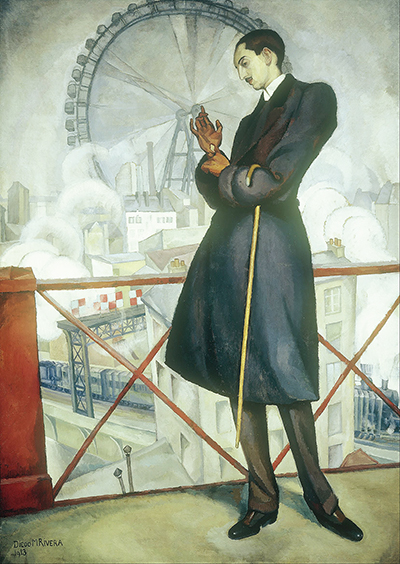Portrait of Adolfo Best Maugard is a painting by Diego Rivera which was completed in 1913, at which point the artist would have been living in Europe. The composition of this painting is complex and also filled with symbolic meaning throughout.
Adolfo Best Maugard was in Paris at around the same time as Rivera, and at the time he was studying various Mexican antiquities which had made their way across to museums within the city. The portrait is carefully sectioned in two, with the subject himself separated visually from the city which lies behind. We see a sprawling metropolis, with smoke bellowing out and series of building's roofs decorating the sky. In contrast, Adolfo Best Maugard looks relaxed and particularly well dressed in the foreground, with the image of a confident man who was entirely comfortable in his surroundings. Adolfo Best Maugard was also known as Fito Best and was most famous as a screenwriter and director, though he also painted successfully as well. He would spend many years in Europe in search of work and creative opportunities, just as Rivera would do during this period of his life. The artist makes him look particularly slim and smart within this painting, thanks to the elegant suit and coat that he wears, alongside a walking stick and leather gloves.
Rivera would unveil this painting under the name of Young Man on the Balcony in 1913 at the Paris Salon des Indépendents. These types of venues were incredibly important for artists looking to gain acceptance for their work, but it was not easily achieved, particularly for those who worked in a non-traditional manner. The painting was sold off to a private collector but after several decades passed it eventually made its way to its present location as a result of a generous bequething. The painting not only features a well crafted portrait, but also advertises the city of Paris as a forward-thinking, lively city which at the time was also leading the art world too. The way in which the gentleman is placed upon a platform, with a visible barrier lying between himself and the city is also an interesting compositional technique which helps to make this piece one of his best from that year.
This painting can today be found at the Museo Nacional de Arte, Ciudad de México, Mexico, which we know in the west as Mexico City. You will discover a wealth of artworks from Rivera's career here, most of which will be out on display more of the time because of the considerable reputation that he built up during his own lifetime. The House on the Bridge can also be found here and this was an artwork that he based on some architecture around the city of Bruges. You will also come across the lesser known but still particularly stunning, Avila Morning [The Ambles Valley], which Rivera completed in around 1908. They also have Zapata-style Landscape from 1915 as well as a wealth of important artworks by a number of other European, Mexican and American artists too. It is an impressive collection which is fitting for such an impressive venue which remains perhaps the most important cultural venue in Mexico City. Rivera was a highly prolific artist which probably explains how so many of his artworks still reside within his native country, when normally you would expect them to have all been snapped up by collectors in Europe and the US.




